Keith Farquhar
ABSTRACT PRINTINGS
November 9–24, 2012
Opening: November 8, 6 pm

Cycling Shorts, 2012, bodypaint on live figure
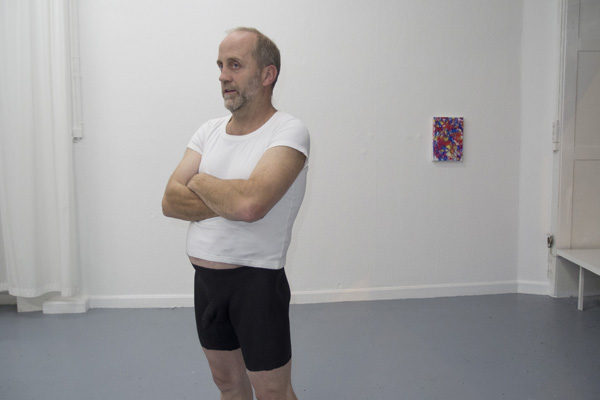
Abstract Printing (Digital America), 2012, UV print on birch ply
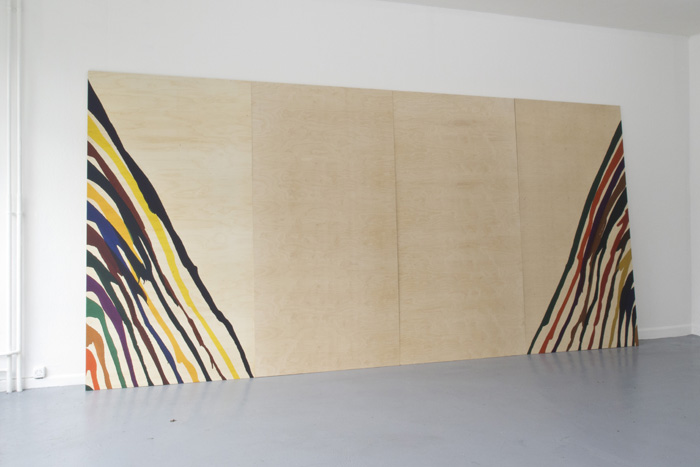
Abstract Printing (In and out of Wool), 2012, UV print on corrugated galvanised steel
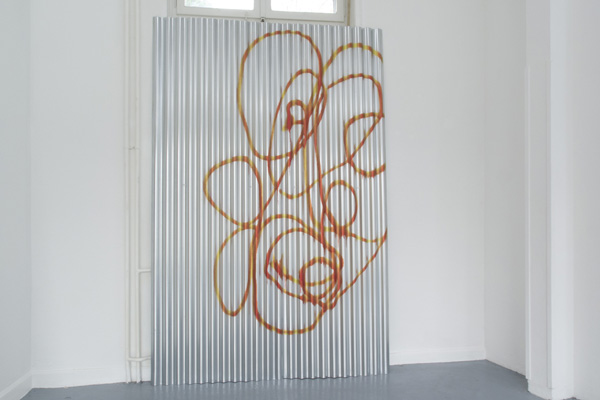
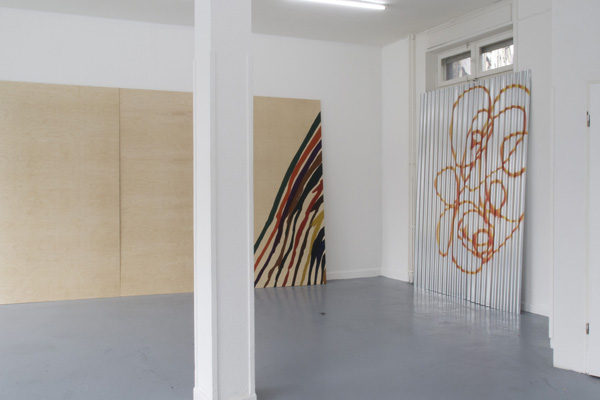

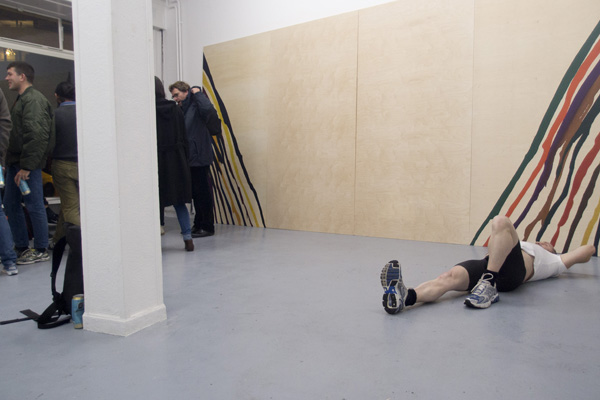

Abstract Printing (Red, Yellow, Blue), 2012, ink-jet on sticker-vinyl on stretcher-frame
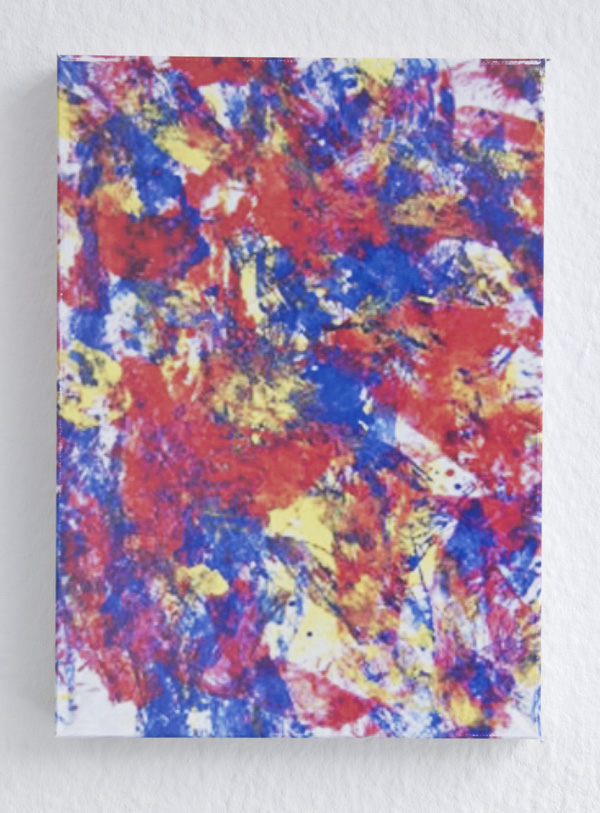
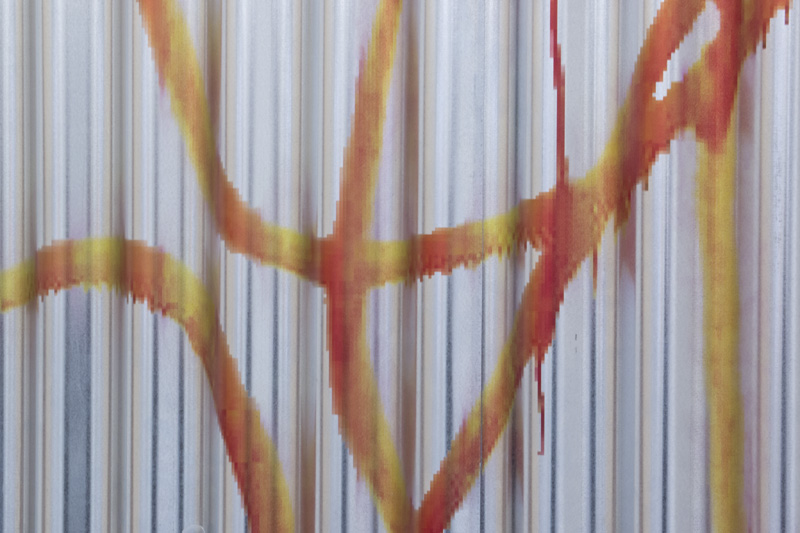
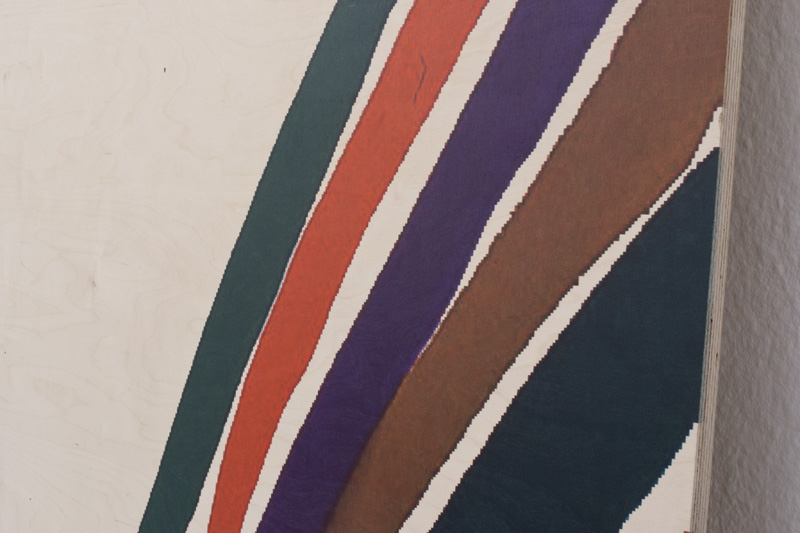

What’s your artistic background?
I left school aged 16 and worked for an insurance company for 3 years – hated it. Fortunately, I got a place to study sculpture at Edinburgh College of Art even though I didn’t have the proper entrance qualifications. I loved Art College and really flourished, gaining a first class BA in sculpture. I then went to London, completing a MA at Goldsmiths over two years. I was fortunate to have had Michael Craig Martin teaching for part of that time. After graduating I ran Deutsche Britische Freundschaft with Thomas Helbig and later Luke Gottelier. We showed amongst others, Andreas Hofer, Enrico David and Lucy McKenzie early in their careers. I was in London for 5 years showing and organising exhibitions and performing in the band The Male Nurse. I’ve been living and working in Edinburgh since about 2001, making work and very occasionally curating. I currently teach part-time on the MFA and for the Intermedia department at Edinburgh College of art.
My artistic background is copying figures from Michelangelo books at secondary school – winning the art prize - my heavy-rock art teacher presenting me with Roger Dean’s Views and Magnetic Storm - leaving school - taking life classes in the evening whilst I worked to get a portfolio together - entering Art College knowing nothing about art and getting hooked right away - Discovering the Americans: Pollock, Morris Louis, Frank Stella, Warhol, Robert Smithson, Bruce Nauman. These guys have stayed with me. Writing my final year thesis on Duchamp - Discovering Kippenberger when the Taschen book first came out and was passed around our group like some heretic tome. Getting post-structuralism forced down our throats at Goldsmiths. In literature- discovering Beckett, William Burroughs, Brett Easton-Ellis, Michel Houellebecq. First seeing Kai Althoff’s Reflux-Lux – remembering the fake vomit. Seeing Wade Guyton’s black paintings like ink-jet Stellas – another paradigm shift.
What was the work you were doing in London like?
At Goldsmiths I began drawing on office white-boards – the type you write on with marker-pens and wipe-off. These were replaced by canvases which I primed with a gloss finish to give them a similar surface to the white-boards: Really a painting ground onto which I could apply marker-pen. I had been collecting Pelican paper-back books – popular psychology and sociology from the late sixties – R.D. Laing’s The Divided Self and the like - as much for the covers as for reading. They had terrific covers depicting archetypal geometric abstractions - such as three intersecting circles and stuff which resembled Op-Art. The books had great titles too such as The Phenomenology of Moral Experience or Mixed Ability Work in Comprehensive Schools. I began to transcribe the designs onto the wipe-clean canvases by hand. One thing I liked was that the marker pens left visible every last mark, so large areas of monochrome-colour became like a wicker-work of solvent stain. The resulting paintings depicted an abstraction which was imperfect and vulnerable: damaged even, like the psychiatric subjects within the pages of RD Laing’s books (and really not so far from the Abstract Printings I’m making for this current show at New Jerseyy).
See these works at www.keithfarquhar.co.uk – click on ‘archived site’ and go to The Cruelty of Psychology
In the early 2000s you started to make assemblages out of clothes and produce a lot of various ready-mades like the “Bastards” series. The arrangements are totally DIY. Sometimes they emerge in different media, like paintings or large-scale installations on a wall. They could be seen as comics about specific sub-cultural movements from indie rock bands to hooliganism.
Yes, comic (as in strip) or cartoon is a good word to describe these works – more obviously the ones presented in 2-dimensions but also the installations. Working with clothing allowed me to draw the human figure very quickly, very economically. The first ones were made with my clothes so the cultural readings are inescapably related back to me. These were developed and serialised in more self-conscious ways. V-necks versus Roundnecks, a 20 meter wide battle scene staged with V-neck and round-neck jumpers was a gearshift in ambition. A desire for hardness and leanness and a way out of narrative led on to the skinheads and hoodies. I was thinking about the sparseness and violence in Bruce Nauman’s work and the skinheads became a literal interpretation of that. The economy developed – the work became even sparer - the interventions eventually becoming so slight that uncut off-the-peg clothing became readymade subjects in themselves. By the time of the late works such as Atomised at Nyehaus New York, a figure could be made from a pair of jeans, a hoodie and 3 shots from a staple gun.
In “Bastards” you were also working with hiking jackets from The North Face. At one point there is a shift. Suddenly the technical-sporty Gore-Tex fabric becomes loaded with an element of sexual fetishization. In your catalogue from 2005, you use the term “GORE-TEXEROTIC”. Another example of this sexualization of sports gear is your “Nudes in Colour” series of body-painted Adidas tights. These series bare similarity to your show at New Jerseyy. At the opening there’s a human sculpture wearing just a t-shirt and trainers. His naked abdomen is covered with body-painted Lycra shorts. He looks as if he’s just come back from doing sports. In Edinburgh, we spoke about body-hugging fabrics. How did your interest on high-tech sports clothing develop?
I hoped that by using clothing such as that made from Gore-Tex and other contemporary technologies that it would embed the work in the present day. The Gore-Tex jackets were later used as painting surfaces. Later still, the painting of Adidas tights and Lycra shorts onto nude models was an attempt at bringing these concerns into the field of expanded painting - finding a significant way to apply paint to a ground, whether it be Acrylic on Gore-Tex, or in the case of the cycling shorts, Body-Paint on male genitalia. The early Bruce Nauman video Black Balls, where the artist applies black paint to his testicles, can be seen as a precursor to this work and my Gore-Tex figures from the show can I b a painting 2 (Galerie Neu, 2002) still make me think of Ashley Bickerton's late 80's works such as Tormented Self Portrait (1988). Looking now I see my attempts at emulating the bullet-proof posturing of these Bickerton works.
For me, light Lycra is also an urban phenomenon, mainly visible through runners. Synthetic sweat-absorbing tights embracing skinny or fat legs. Constantly moving bodies breathing heavily, armed with self-reflective applications. The sound of trainers hitting the concrete, or the rustle of a polyamide jacket coming into contact with itself. In general, jogging is an economic, spontaneous after-work leisure activity that perpetuates an image of healthy, mobile, metropolitan lifestyles that motivates one to keep our bodies in-shape.
Here in the UK, Gore-Tex is the norm, its functionality having been originally utilised by the middle classes for their outdoor pursuits. Its wearers were modern day Athenians; the Roman citizens of now, until it proliferated, like other specialised brands had done before it, as market-driven fashion across the urbanised working class. Now everyone wears Gore-Tex.
How often have live figures appeared as sculptures during your openings?
I think this is a first. Although you say sculpture and I’m inclined to think of it as painting.
I like both ideas. There is a resistant aspect that we have to deal with—the idea of an individual biological organism as an artwork. It's hard also to distinguish if it’s a performance or a temporary living painting. After the opening, the model will continue with his daily life, like you and me. There won’t be any traces left in the gallery space. But with the “Flat Pack Statues”, you produce an ongoing value or visibility—actual objects—out of these acts. Can you tell us more about this series?
The flat-pack statues are made by applying paint – often lots of paint- in a quite random fashion to a nude model in the studio. The model or part of the model is then photographed and the images are emailed to a manufacturer of novelty cardboard cut-outs where they are printed, cut and made-up into 2D photographic trompe l'oeil sculptures in cardboard - what I call flat-pack statues. The sculptures are presented on self-assembly flat-pack pedestals made from the same card. The works incorporate painting, photography and sculpture in almost equal measures. They take up the same visual space as a 3D bronze especially in documentation yet there isn’t really much materialism to them and what there is is disposable. I like the idea of them being remade from the original photo-file after they are damaged or wear out – of them never having to get old – to stay in a perpetual state of brand-newness. I see them as an attempt to make figurative sculpture in the age of human genome mapping: There is an analogy between the digital code of the stored photo-files of the models awaiting printing and fabrication and that of a digital genome code of a mapped human subject with the potential for cloning.
It’s interesting how you can treat technology in this silent way—in the end it always looks handmade. But far from being simple, handmade materials, these works are assembled via a complicated printing technologies mainly used in the field of advertising. Yet in your show at New Jerseyy, the large appropriated master paintings of Morris Louis resemble anthroposophic Kindergarten interiors, while the works from Christopher Wool take on material tactility of a makeshift corrugated shelter. For you, does this process adjoin iconoclasm or even play with a complicated father-son relation?
It started with the technology – discovering direct UV printing – then getting behind the scenes and having the opportunity to play with the technology – test its parameters – misuse it if you like. Finding out through trial and error what materials would work and what wouldn’t. Realising I could raise the machine’s print-heads from the printed surface and thus diffuse the ink-jet into a spray - use the printer to spray-paint if you like. This led me to seek out photographic images of spray-paint with the perverse intention of getting the printer to turn them back into actual spray. I appropriated the Chris Wool piece because I realised it was totally unimportant for my work to begin with its own original gesture created by my hand – Its gesture would be made by gravity’s randomising effect on the jet of ink leaving the raised print-heads. Printing onto corrugations further increased the perversity of the process: As the print-heads pass over the peak of the corrugation, a normal photographic image of the spray-paint gesture is printed; where they pass over the trough of the corrugation the diffusing takes place. Thus, the image alternates between a digital photographic image of spray-paint and actual spray-paint and back again ad infinitum.
Iconoclasm is important. I’m a great admirer of both the Louis and Wool works, yet their iconic status doesn’t stop me from treating them with irreverence; cannibalising their graven image to make anew. It makes increasing sense for obsessives such as myself to use previous art as the raw material for the production of new work. This seems both a logical progression and an inescapable reality. Following the Morris Louis work, and in response to your complicated father-son relationship issue I am now considering the possibility of appropriating both Ken and Cady Noland (father and daughter) in one incestuous work.
Art as a witty comment?
There has to be more than a joke. I remember arguing with my peers about Kippenberger when they would say his art is only a joke. I suppose I could see the tragedy too – maybe more clearly than them - real pathos. I’m put off by smugness in art – art which is self-satisfied or has an in-built answer for everything. I have been at times not without guilt myself.